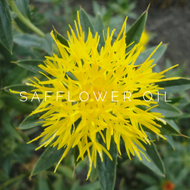Safflower - Ingredient Highlight
Posted by Bre-Ana Brown on 8th Jul 2019
Did you know that safflower is one of the oldest crops in human history? Use of safflower dates all the way back to the twelfth dynasty! Tapestries from that dynasty were dyed with safflower. Ancient Egyptians used the bright red orange, and yellow from safflower flowers to dye mummy wrappings. Pharaoh Tutankhamun from the eighteenth dynasty was found buried in his tomb with garlands that contained safflower. This ancient civilization also used another part of safflower to treat insect and scorpion bites- the oil derived from safflower seeds.
Safflower oil is produced by cold (never exceed 120 degrees) pressing or expeller pressing the seeds. Unrefined safflower oil is best. Our safflower oil is organically grown and cold pressed to preserve the nutritional value. How do you know if your safflower oil is truly unrefined? It should have an earthy and slightly nutty flavor as well as be a deep yellow-orange color. Typically safflower oil that has been refined is pale and fairly bland to taste. In our products, you may sometimes see a sediment in the bottom of them. This is just the fine safflower pulp settling to the bottom.
My word of the day is comedogenic... which according to the New Oxford American dictionary means “tending to cause blackheads by blocking the pores of the skin." What does that have to do with safflower oil? Safflower oil has a comedogenic rating of zero! What does that mean? Well, the Comedogenic rating scale rates how likely ingredients such as oils and butters are to clog pores. A ranking of zero means it won’t clog pores at all! How awesome is that? We love that fact about safflower oil and that’s one reason why we choose to use it as a staple ingredient in our skin care products!
Safflower oil contains high amounts of vitamin E, linoleic acid and various antioxidants that help to fight free radicals, UV damage and also lessen the signs of aging! Safflower oil also has been shown to be a penetration enhancer. What does that mean? Just like vitamin D enhances the absorption of calcium in our bodies. Safflower oil can help other beneficial ingredients in skin care products to enter into your skin cells! How cool is that! It’s another reason we love using safflower oil as a base ingredient in our skin care products.
